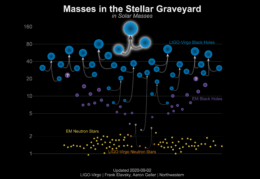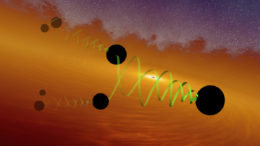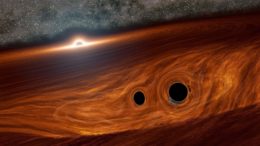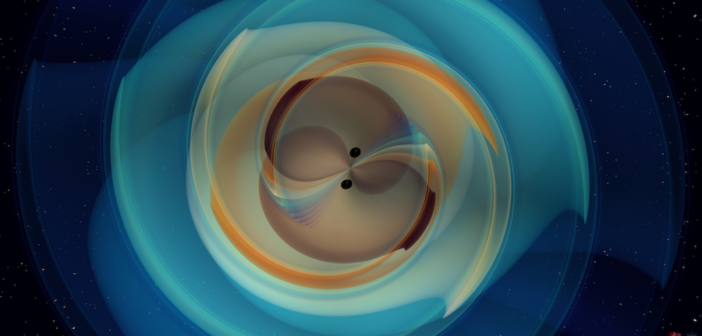Been waiting for new signals to be parsed from LIGO/Virgo’s third observing run data? Wait no longer! The latest detection announced in Physical Review Letters and ApJ Letters is big news — both figuratively and literally. The two black holes that merged in GW190521 are the most massive we’ve observed yet, and this has major astrophysical implications.
The Signal

Most recent version of the “stellar graveyard”, a plot that shows the masses of the different components of observed compact binary mergers. GW190521, seen at the top center, is more massive than any other binary merger we’ve observed. Click to enlarge. [LIGO-Virgo/Northwestern U./Frank Elavsky & Aaron Geller]
This signal is unique, record-breaking, and extremely intriguing for two reasons. First, the final product of the merger is ~142 times the mass of the Sun, which places it firmly in the category of elusive intermediate-mass black holes. And second, the two merging black holes had masses of ~85 and ~66 solar masses, which virtually guarantees that at least one of them falls into the so-called pair-instability mass gap.
A Decidedly Intermediate Size
Let’s unpack these things, starting with the final product.
The black holes astronomers have thus far observed in the universe fall into two primary categories: stellar-mass black holes (on the order of ~10 solar masses), and supermassive black holes (millions to tens of billions of solar masses).
Intermediate-mass black holes (IMBHs) should exist as a bridge between the two, spanning the range of 100–100,000 solar masses. Until now, however, evidence for these bodies has been slim: only a few candidates, all with masses at the upper end of the IMBH mass range, have been identified.
The detection of GW190521’s 142-solar-mass final product therefore marks a major discovery in a black-hole-mass desert. It confirms not only that IMBHs do exist, but also that they can be formed by the merger of two smaller black holes.

Illustration of the steps of a hierarchical merger, in which four stellar-mass black holes combine in pairs to eventually form a single, large black hole. [LIGO/Caltech/MIT/R. Hurt (IPAC)]
Polluting the Mass Gap
Stellar-mass black holes form when a massive star evolves and collapses at the end of its lifetime. But there’s an instability that’s thought to get in the way for some stars, expelling mass and preventing black holes of a certain range of masses from forming.
This forbidden pair-instability mass gap lies roughly between 65 and 120 solar masses — and yet the masses of the merging black holes in GW190521 fall squarely within that range!
How can this be? The LIGO/Virgo collaboration outlines a few possible ways to defy the mass gap:
- Second-generation black holes
Black holes that formed from the merger of two smaller black holes (instead of from the collapse of a star) can lie within the mass gap. GW190521 might be the result of four stellar-mass black holes undergoing progressive hierarchical mergers to eventually form an intermediate-mass black hole. - Stellar mergers in young star clusters
In some scenarios, the merger of an evolved star with a main-sequence companion can create a giant star with an oversized envelope. This type of star could collapse directly into a black hole that lies in the mass gap. - Black-hole mergers in the disks of active galactic nuclei

Artist’s illustration of two merging black holes embedded in the gas disk surrounding a supermassive black hole. [Caltech/R. Hurt (IPAC)]
The disk of material that feeds the supermassive black hole at the center of an active galaxy may host tens of thousands of stellar-mass black holes. Trapped in the disk, these smaller black holes can more efficiently accrete material and merge, providing an avenue for rapid growth into mass-gap sizes.
Going Forward
We can’t yet be sure whether GW190521 represents a new kind of black hole binary, or if it’s simply the upper-mass end of the population we’ve already observed. But this will soon change, as upgrades to the LIGO/Virgo network’s sensitivity should allow for the detection of several hundreds of mergers per year, reaching ever higher redshifts. And next-generation ground- and space-based detectors will soon provide an additional perspective.
With the surprising discoveries of GW190521, one thing is clear: the paradigm shifts from gravitational-wave astronomy are only just beginning.
Citation
“Properties and Astrophysical Implications of the 150M☉ Binary Black Hole Merger GW190521,” Abbott et al 2020 ApJL 900 L13. doi:10.3847/2041-8213/aba493


11 Comments
Pingback: Ungewöhnliche Gravitationwelle – mit Leuchten? | Skyweek Zwei Punkt Null
Pingback: From AAS NOVA: “LIGO/Virgo’s Newest Merger Defies Mass Expectations” | sciencesprings
Pingback: From AAS NOVA: “History as Told by a Merger Background” | sciencesprings
Pingback: History as Told by a Merger Background
Pingback: Ultraluminous X-ray Sources and their Near-Infrared Counterparts | astrobites
Pingback: Exploding Stars in Black Hole Disks
Pingback: Redefining a Heavy Collision
Pingback: Redefining a Heavy Collision - Sky & Telescope - Night Vision Now
Pingback: Redefining a Heavy Collision – Sky & Telescope – §Framework Info§
Pingback: Redefining a Heavy Collision – Sky & Telescope - Orbit Blender
Pingback: Reanalyzing LIGO-Virgo gravitational wave events under the new lens of… lensing! | astrobites